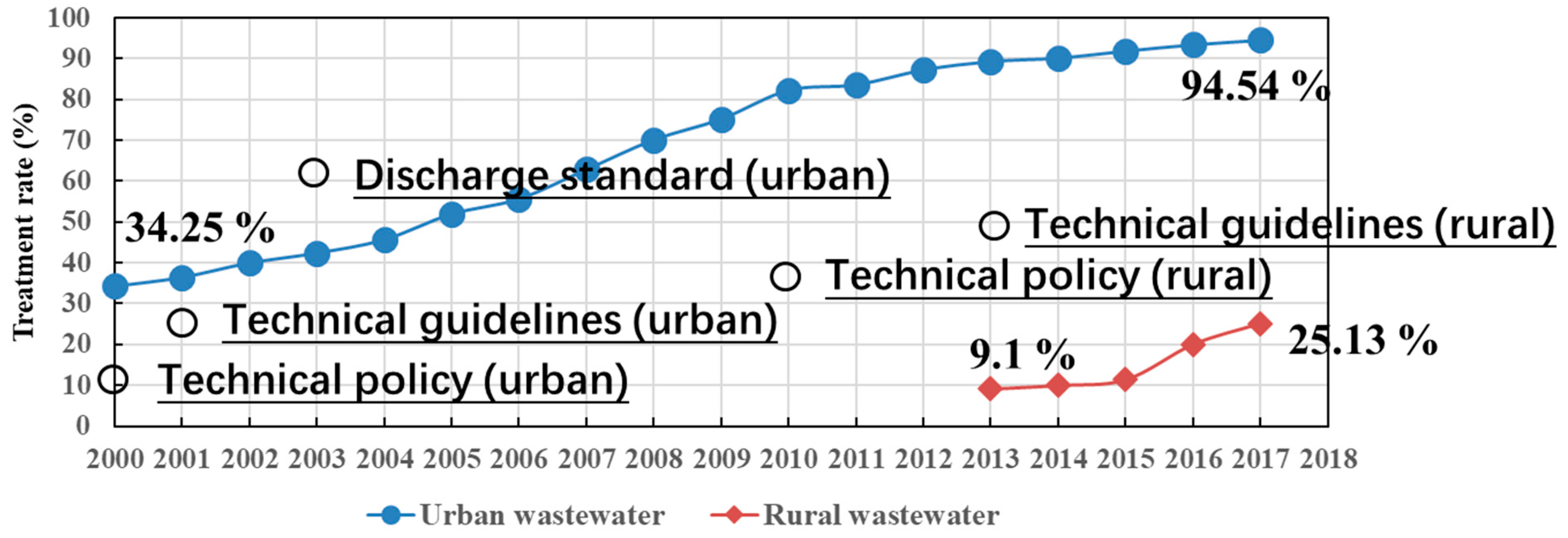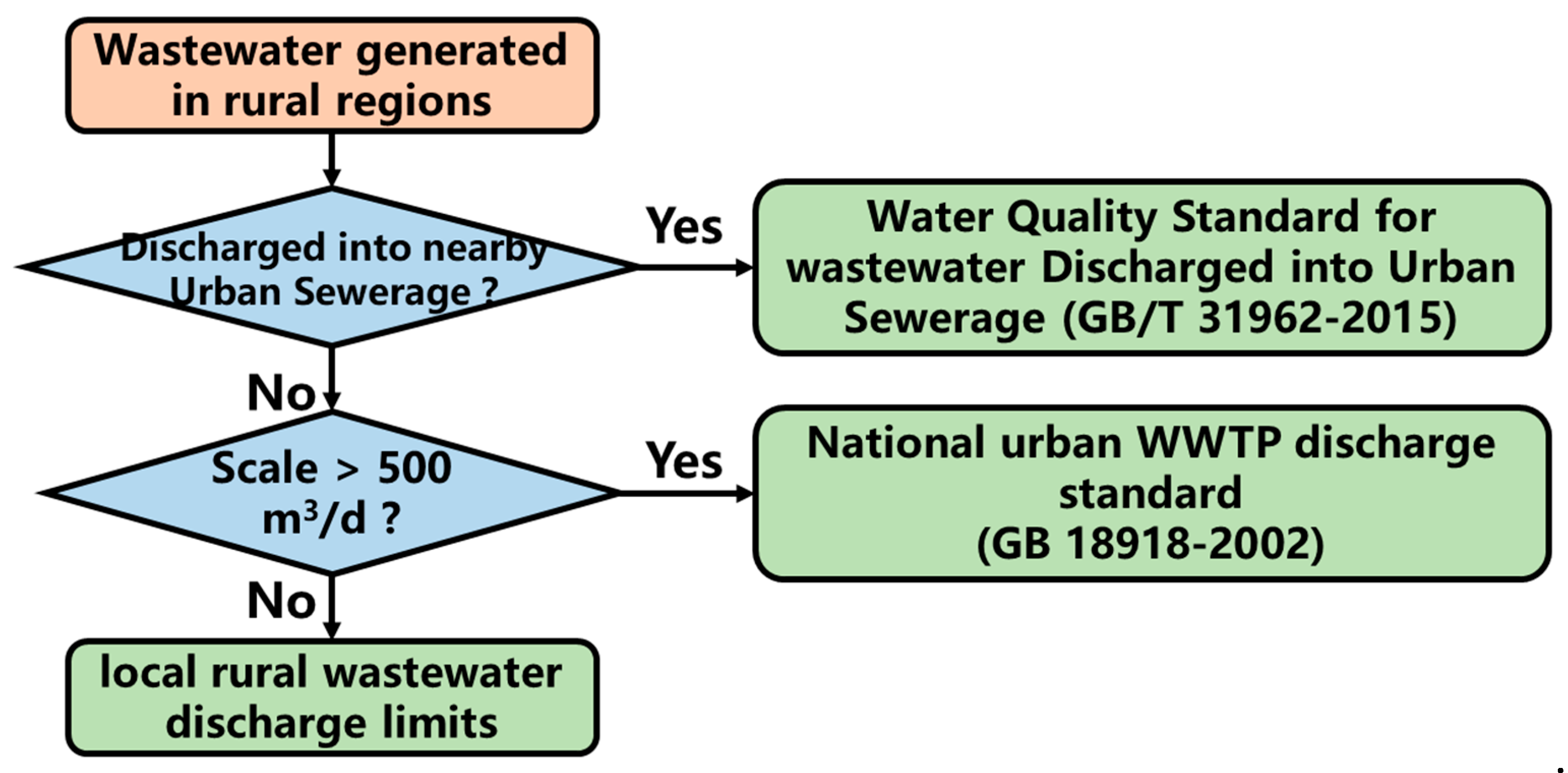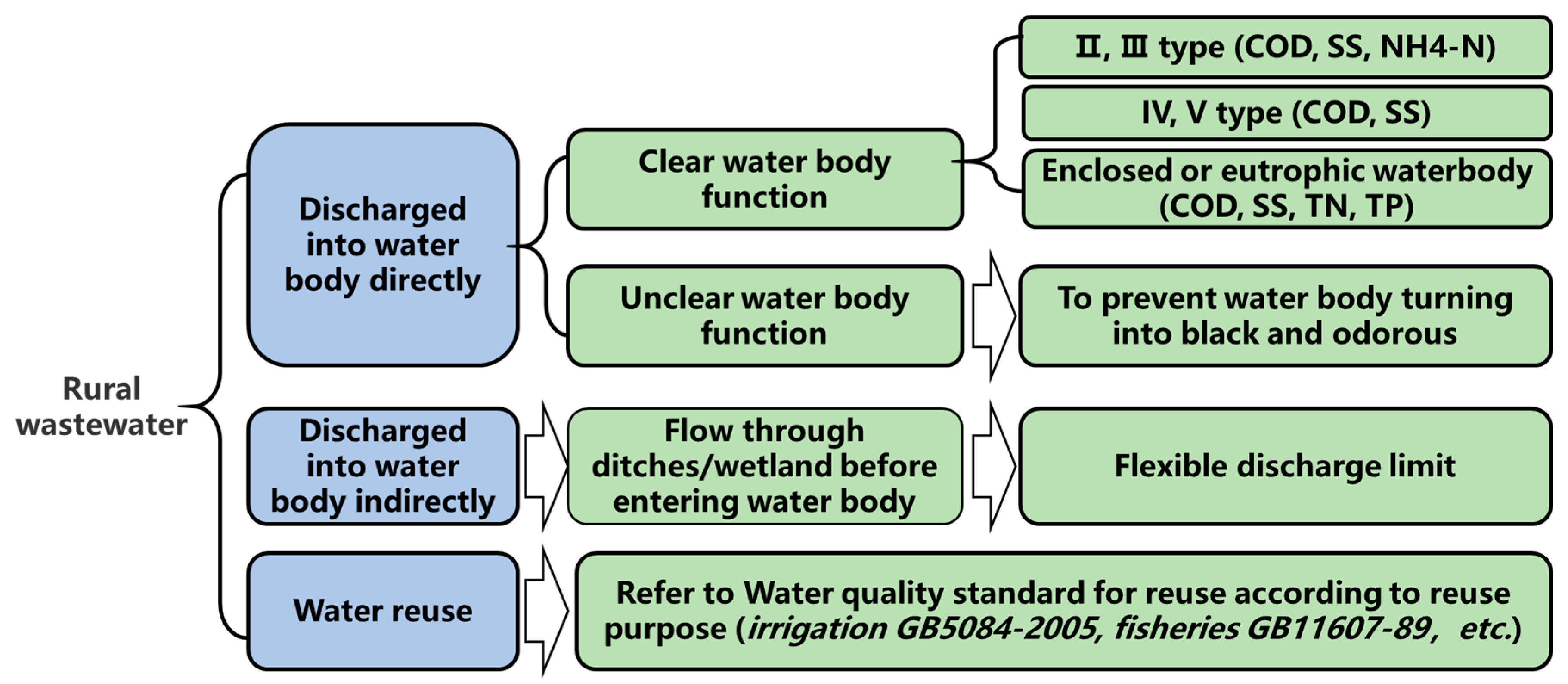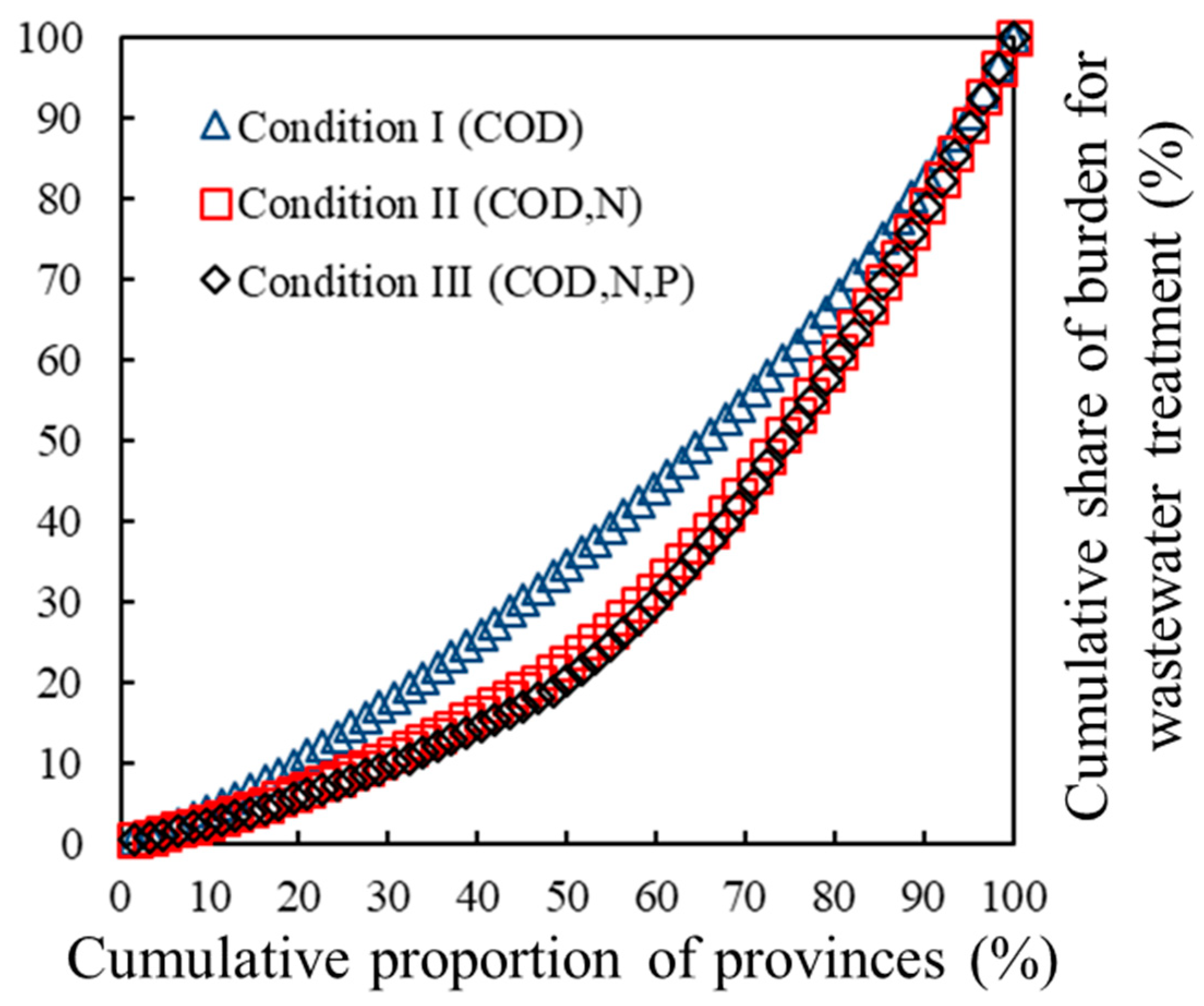Expected Rural Wastewater Treatment Promoted by Provincial Local Discharge Limit Legislation in China
Abstract
Highlights
- Rural wastewater treatment lags behind urban regions both in treatment capacity and legislation.
- China plans to promote nationwide local rural wastewater discharge limit legislations for the first time.
- Flexible discharge limits help to alleviate the imbalanced economic burden for urban and rural regions.
1. Introduction
2. Methodology
2.1. Data Sources and Economic Burden Calculation for Wastewater Treatment
2.2. The Gini Coefficient Method
3. Results and Discussion
3.1. The Undeveloped Rural Wastewater Treatment in China and Current Regional Discharge Limits
3.2. The Top-Level Designed Nationwide Policy for Speeding Up the Issue of Provincial Local Rural Wastewater Discharge Limits
- Extending the urban wastewater network to surrounding rural villages in suburbs.
- Promoting easy-to-maintain, low-cost, and low-energy wastewater treatment technologies, with ecological processes encouraged.
- Encouraging a reduction in sources of wastewater generation and the reuse of treated wastewater.
- Making full use of existing facilities for waste disposal, such as biogas digesters, strengthening the effective connection between toilet improvement and rural domestic sewage treatment, adopting appropriate ways to treat or utilize toilet waste harmlessly, and strictly forbidding the direct discharge of untreated toilet waste into the environment.
3.3. The Economic Burden for Rural and Urban Wastewater Treatment under Various Discharge Limit Conditions
4. Conclusions
- Wastewater treatment in rural regions in China is undeveloped both in treatment capacity and legislation. The successful fast development of urban wastewater treatment plants (WWTPs) demonstrates the importance of legislation, including discharge limits. However, most provinces, including as much as 79.8% of the rural population in China, have released no specific local discharge limits.
- Newly issued top-level designed nationwide policy in September 2018 proposed flexible principles for the determination of discharge limits under various conditions to improve the rural residential environment as a whole. The limited existing local rural wastewater discharge limits demonstrate inconsistency due to the lack of top-level designed nationwide policy, with some provinces emphasizing environmental sensitivity with discharge limits equal or even stricter than urban standards while others focus on resource recovery with less stringent discharge limits.
- Based on the three conditions described in the new policy, the average burden for urban residents was estimated as 0.122 ± 0.038% of the total life expense. In comparison, the average nationwide rural burden was 0.087 ± 0.035% and 0.564 ± 0.196% for condition I (TN/TP for resource recovery) and condition III (TN/TP for pollutant removal), respectively.
- Stringent rural discharge limits led to Gini values as high as 0.38, indicating that policy-related subsidies for rural residents should be carefully considered to ensure a balanced burden. In comparison, discharge limits with nutrient recovery achieved a 0.22 Gini value with improved equity.
Author Contributions
Funding
Conflicts of Interest
References
- Wang, Z. China’s Wastewater Treatment Goals. Science 2012, 338, 604. [Google Scholar] [CrossRef]
- Massoud, M.A.; Tarhini, A.; Nasr, J.A. Decentralized approaches to wastewater treatment and management: Applicability in developing countries. J. Environ. Manag. 2009, 90, 652–659. [Google Scholar] [CrossRef] [PubMed]
- Chen, K.; Liu, X.; Ding, L.; Huang, G.; Li, Z. Spatial Characteristics and Driving Factors of Provincial Wastewater Discharge in China. Int. J. Environ. Res. Public Health 2016, 13, 1221. [Google Scholar] [CrossRef]
- Skoczko, I.; Struk-Sokołowska, J.; Ofman, P. Seasonal Changes In Nitrogen, Phosphorus, Bod And Cod Removal In Bystre Wastewater Treatment Plant. J. Ecol. Eng. 2017, 18, 185–191. [Google Scholar] [CrossRef]
- Skoczko, I.; Struk-Sokołowska, J.; Ofman, P. Modelling Changes in the Parameters of Treated Sewage Using Artificial Neural Networks. Ann. Set Environ. Protect. 2017, 19, 633–650. [Google Scholar]
- Wang, M.; Gong, H. Not-in-My-Backyard: Legislation Requirements and Economic Analysis for Developing Underground Wastewater Treatment Plant in China. Int. J. Environ. Res. Public Health 2018, 15, 2339. [Google Scholar] [CrossRef]
- Suchetana, B.; Rajagopalan, B.; Silverstein, J. Assessment of wastewater treatment facility compliance with decreasing ammonia discharge limits using a regression tree model. Sci. Total Environ. 2017, 598, 249–257. [Google Scholar] [CrossRef]
- Bai, S.; Zhang, X.; Xiang, Y.; Wang, X.; Zhao, X.; Ren, N. HIT.WATER scheme: An integrated LCA-based decision-support platform for evaluation of wastewater discharge limits. Sci. Total Environ. 2019, 655, 1427–1438. [Google Scholar] [PubMed]
- Zhou, Y.; Yang, B.; Han, J.; Huang, Y. Robust Linear Programming and Its Application to Water and Environmental Decision-Making under Uncertainty. Sustainability 2018, 11, 33. [Google Scholar] [CrossRef]
- Molero-Simarro, R. Inequality in China revisited. The effect of functional distribution of income on urban top incomes, the urban-rural gap and the Gini index, 1978–2015. China Econ. Rev. 2017, 42, 101–117. [Google Scholar] [CrossRef]
- Wang, C. An Analysis of Rural Household Livelihood Change and the Regional Effect in a Western Impoverished Mountainous Area of China. Sustainability 2018, 10, 1738. [Google Scholar] [CrossRef]
- Wang, M.; Gong, H. Imbalanced Development and Economic Burden for Urban and Rural Wastewater Treatment in China—Discharge Limit Legislation. Sustainability 2018, 10, 2597. [Google Scholar] [CrossRef]
- Yu, X.; Geng, Y.; Heck, P.; Xue, B. A Review of China’s Rural Water Management. Sustainability 2015, 7, 5773. [Google Scholar] [CrossRef]
- Song, P.; Huang, G.; An, C.; Shen, J.; Zhang, P.; Chen, X.; Shen, J.; Yao, Y.; Zheng, R.; Sun, C. Treatment of rural domestic wastewater using multi-soil-layering systems: Performance evaluation, factorial analysis and numerical modeling. Sci. Total Environ. 2018, 644, 536–546. [Google Scholar] [CrossRef]
- Schäfer, A.I.; Hughes, G.; Richards, B.S. Renewable energy powered membrane technology: A leapfrog approach to rural water treatment in developing countries? Renew. Sustain. Energy Rev. 2014, 40, 542–556. [Google Scholar] [CrossRef]
- Lambert, P.J. Social welfare and the gini coefficient revisited. Math. Soc. Sci. 1985, 9, 19–26. [Google Scholar] [CrossRef]
- Farris, F.A. The Gini Index and Measures of Inequality. Am. Math. Mon. 2010, 117, 851–864. [Google Scholar] [CrossRef]
- Chen, J.; Wu, Y.; Song, M.; Dong, Y. The residential coal consumption: Disparity in urban–rural China. Resour. Conserv. Recycl. 2018, 130, 60–69. [Google Scholar] [CrossRef]
- Dong, L.; Liang, H. Spatial analysis on China’s regional air pollutants and CO2 emissions: Emission pattern and regional disparity. Atmos. Environ. 2014, 92, 280–291. [Google Scholar] [CrossRef]
- Druckman, A.; Jackson, T. Measuring resource inequalities: The concepts and methodology for an area-based Gini coefficient. Ecol. Econ. 2008, 65, 242–252. [Google Scholar] [CrossRef]
- Jacobson, A.; Milman, A.D.; Kammen, D.M. Letting the (energy) Gini out of the bottle: Lorenz curves of cumulative electricity consumption and Gini coefficients as metrics of energy distribution and equity. Energy Policy 2005, 33, 1825–1832. [Google Scholar] [CrossRef]
- Tao, S.; Zhang, H.W.; Yuan, W.; Meng, X.M.; Wang, C.W. The application of environmental Gini coefficient (EGC) in allocating wastewater discharge permit: The case study of watershed total mass control in Tianjin, China. Resour. Conserv. Recycl. 2010, 54, 601–608. [Google Scholar]
- Yuan, Q.; McIntyre, N.; Wu, Y.; Liu, Y.; Liu, Y. Towards greater socio-economic equality in allocation of wastewater discharge permits in China based on the weighted Gini coefficient. Resour. Conserv. Recycl. 2017, 127, 196–205. [Google Scholar] [CrossRef]
- Gong, H.; Jin, Z.; Xu, H.; Yuan, Q.; Zuo, J.; Wu, J.; Wang, K. Enhanced membrane-based pre-concentration improves wastewater organic matter recovery: Pilot-scale performance and membrane fouling. J. Clean. Prod. 2019, 206, 307–314. [Google Scholar] [CrossRef]
- Wang, Z.; Gong, H.; Zhang, Y.; Liang, P.; Wang, K. Nitrogen recovery from low-strength wastewater by combined membrane capacitive deionization (MCDI) and ion exchange (IE) process. Chem. Eng. J. 2017, 316, 1–6. [Google Scholar] [CrossRef]
- Fang, K.; Gong, H.; He, W.; Peng, F.; He, C.; Wang, K. Recovering ammonia from municipal wastewater by flow-electrode capacitive deionization. Chem. Eng. J. 2018, 348, 301–309. [Google Scholar] [CrossRef]
- Wang, J.; Zhang, T.; Chen, J. Cost model for reducing total COD and ammonia nitrogen loads in wastewater treatment plants. China Environ. Sci. 2009, 29, 443–448. (In Chinese) [Google Scholar]
- Gong, H.; Jin, Z.; Xu, H.; Wang, Q.; Zuo, J.; Wu, J.; Wang, K. Redesigning C and N mass flows for energy-neutral wastewater treatment by coagulation adsorption enhanced membrane (CAEM)-based pre-concentration process. Chem. Eng. J. 2018, 342, 304–309. [Google Scholar] [CrossRef]
- An, M.; He, W.; Degefu, D.M.; Liao, Z.; Zhang, Z.; Yuan, L. Spatial Patterns of Urban Wastewater Discharge and Treatment Plants Efficiency in China. Int. J. Environ. Res. Public Health 2018, 15, 1892. [Google Scholar] [CrossRef] [PubMed]
- Xu, W. Methods for calculating Gini coefficient. Stat. Dec. 2004, 15, 121–122. [Google Scholar]
- Kleiber, C.; Kotz, S. A characterization of income distributions in terms of generalized Gini coefficients. Soc. Choice Welf. 2002, 19, 789–794. [Google Scholar] [CrossRef]
- Zhang, Z.; Xue, B.; Pang, J.; Chen, X. The Decoupling of Resource Consumption and Environmental Impact from Economic Growth in China: Spatial Pattern and Temporal Trend. Sustainability 2016, 8, 222. [Google Scholar] [CrossRef]
- Horn, T.B.; Zerwes, F.V.; Kist, L.T.; Machado, Ê.L. Constructed wetland and photocatalytic ozonation for university sewage treatment. Ecol. Eng. 2014, 63, 134–141. [Google Scholar] [CrossRef]
- Ren, X.; Shon, H.K.; Jang, N.; Lee, Y.G.; Bae, M.; Lee, J.; Cho, K.; Kim, I.S. Novel membrane bioreactor (MBR) coupled with a nonwoven fabric filter for household wastewater treatment. Water Res. 2010, 44, 751–760. [Google Scholar] [CrossRef]




| Rural Regions | COD (mg/L) | NH4−N (mg/L) | TP (mg/L) | Wastewater Amount 2 (L/(Person·d)) | Provinces Included 3 |
|---|---|---|---|---|---|
| Northeast | 325 1 (200–450) | 55 (20–90) | 4.25 (2.0–6.5) | 65 (40–90) | Heilongjian, Jilin, Inner Mongolia, Liaoning |
| North China | 325 (200–450) | 55 (20–90) | 4.25 (2.0–6.5) | 60 (40–80) | Beijing, Tianjin, Heibei, Shanxi, Shandong |
| Northwest | 250 (100–400) | 26 (3–50) | 3.5 (1.0–6.0) | 45 (50–90) | Shaanxi, Gansu, Qinghai, Ningxia, Xinjiang |
| Southeast | 300 (150–450) | 35 (20–50) | 3.75 (1.5–6.0) | 90 (80–100) | Jiangsu, Shanghai, Zhejiang, Fujian, Guangdong, Hainan |
| Central south | 200 (100–300) | 50 (20–80) | 4.5 (2.0–7.0) | 90 (60–120) | Henan, Hubei, Hunan, Anhui, Jiangxi |
| Southwest | 275 (150–400) | 35 (20–50) | 4 (2.0–6.0) | 90 (60–120) | Sichuan, Yunnan, Guizhou, Chongqing, Guangxi, Tibet |
| Urban Regions (City) | Rural Regions | |||
|---|---|---|---|---|
| Year | WWTP Amount | Capacity (104 t/d) | Treatment Rate (%) | Treatment Rate (%) |
| 2000 | 427 | 2157.84 | 34.25 | /* |
| 2001 | 452 | 3106.25 | 36.43 | / |
| 2002 | 537 | 3578 | 39.97 | / |
| 2003 | 612 | 4253.6 | 42.39 | / |
| 2004 | 708 | 4912 | 45.67 | / |
| 2005 | 792 | 5725 | 51.95 | / |
| 2006 | 815 | 6366 | 55.67 | / |
| 2007 | 883 | 7146 | 62.87 | / |
| 2008 | 1018 | 8106 | 70.16 | / |
| 2009 | 1214 | 9052 | 75.25 | / |
| 2010 | 1444 | 10,436 | 82.31 | / |
| 2011 | 1588 | 11,303 | 83.63 | / |
| 2012 | 1670 | 11,733 | 87.3 | / |
| 2013 | 1736 | 12,454 | 89.34 | 9.1 |
| 2014 | 1807 | 13,087 | 90.18 | 9.98 |
| 2015 | 1943 | 14,028 | 91.9 | 11.4 |
| 2016 | 2039 | 14,910 | 93.44 | 20 |
| 2017 | 2209 | 15,743 | 94.54 | 25.13 |
| Types | Main Characteristics | Provinces | Population Ratio (%) |
|---|---|---|---|
| A | Similar to urban standard | Fujian, Hebei and Shaanxi | 11.3 |
| B | More stringent than urban standard | Beijing | 0.5 |
| C | More flexible limits than urban standard | Zhejiang and Chongqing | 5.1 |
| D | Emphasizing ecological resource recovery | Ningxia and Shanxi | 3.3 |
| E | Others (no specific local discharge limits were released while urban limits were borrowed and referred) | All the rest provinces not mentioned above | 79.8 |
| Urban | Rural-Condition I | Rural-Condition II | Rural-Condition III | |
|---|---|---|---|---|
| Average economic burden for wastewater treatment | 0.122 ± 0.038% | 0.087 ± 0.035% | 0.490 ± 0.172% | 0.564 ± 0.196% |
| 1st Highest | 2nd Highest | 3rd Highest | 1st Lowest | 2nd Lowest | 3rd Lowest | |
|---|---|---|---|---|---|---|
| Condition I | Beijing urban 0.219% | Ningxia urban 0.189% | Jiangsu urban 0.164% | Hubei rural 0.035% | Hunan rural 0.036% | Anhui rural 0.037% |
| Condition II | Shanxi rural 0.627% | Hainan 0.596% | Heilongjian rural 0.579% | Guizhou urban 0.063% | Yunnan urban 0.069% | Jiangxi urban 0.075% |
| Condition III | Shanxi rural 0.701% | Hainan rural 0.695% | Tibet rural 0.665% | Guizhou urban 0.063% | Yunnan urban 0.069% | Jiangxi urban 0.075% |
© 2019 by the authors. Licensee MDPI, Basel, Switzerland. This article is an open access article distributed under the terms and conditions of the Creative Commons Attribution (CC BY) license (http://creativecommons.org/licenses/by/4.0/).
Share and Cite
Wang, M.; Gong, H. Expected Rural Wastewater Treatment Promoted by Provincial Local Discharge Limit Legislation in China. Sustainability 2019, 11, 2756. https://doi.org/10.3390/su11102756
Wang M, Gong H. Expected Rural Wastewater Treatment Promoted by Provincial Local Discharge Limit Legislation in China. Sustainability. 2019; 11(10):2756. https://doi.org/10.3390/su11102756
Chicago/Turabian StyleWang, Meishu, and Hui Gong. 2019. "Expected Rural Wastewater Treatment Promoted by Provincial Local Discharge Limit Legislation in China" Sustainability 11, no. 10: 2756. https://doi.org/10.3390/su11102756
APA StyleWang, M., & Gong, H. (2019). Expected Rural Wastewater Treatment Promoted by Provincial Local Discharge Limit Legislation in China. Sustainability, 11(10), 2756. https://doi.org/10.3390/su11102756






